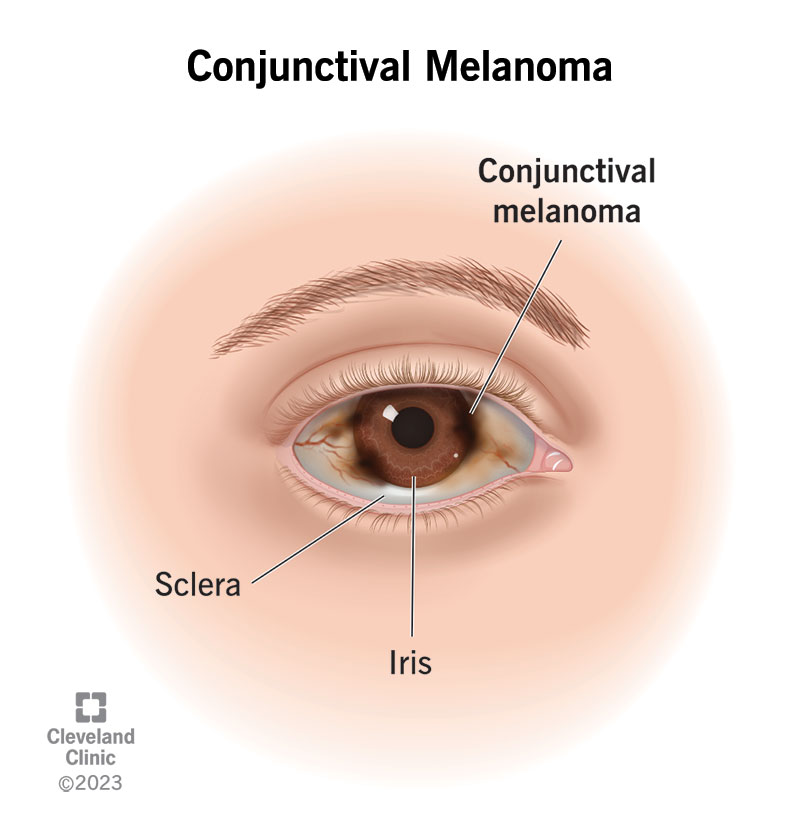Conjunctival melanoma, or conjunctival malignant melanoma, is a rare cancer that happens in the tissue that protects the whites of your eyes and your eyelids. It may not cause symptoms at first. Treatment options include surgery and cryotherapy.

Conjunctival melanoma, or malignant (cancerous) melanoma of the conjunctiva, is a rare type of eye cancer. Some people call it conjunctival malignant melanoma.
The condition affects the clear tissue that covers the inside of your eyelids and the white part of your eye (called the sclera). Most often, conjunctival melanoma affects the bulbar conjunctiva, or the mucous membrane that protects your sclera.
Conjunctival melanoma is a type of ocular melanoma, or melanoma of the eye. Melanoma starts with the uncontrolled growth of melanocytes, or cells that make the pigment called melanin. Melanin is what gives hair, skin and eyes their color. Melanoma happens most often in your skin.
Conjunctival melanoma can be fatal.
Conjunctival melanoma is a rare type of eye cancer, amounting to about 2% of all tumors in the eye and about a quarter of 1% (0.25%) of all melanomas. The incidence has been increasing in recent years.
In the Western world, conjunctival melanoma has an incidence rate of 0.2 to 0.5 cases per 1 million people annually. It happens most often in non-Hispanic white people, but people of Asian descent, Black people and Hispanics can also get the disease. It rarely happens in children.
Conjunctival melanoma is a different type of eye cancer than retinoblastoma or intraocular melanoma. Intraocular melanoma affects the uvea (the eye’s middle layer) and is the most common type of eye cancer. Retinoblastoma affects the retina at the back of the eye.
Cleveland Clinic is a non-profit academic medical center. Advertising on our site helps support our mission. We do not endorse non-Cleveland Clinic products or services. Policy
Melanoma of the eye may not cause symptoms at first. If you develop signs and symptoms of conjunctival melanoma, they may include a spot that:
Because conjunctival melanoma is so rare, researchers aren’t sure what causes it. Genetics may play a role, but it’s not contagious and doesn’t spread from one person to another. Two conditions have a more defined link to developing conjunctival melanoma. These are:
Risk factors for ocular (eye) melanoma in general include:
Scientists think exposure to ultraviolet light may also be a risk factor.
Untreated melanoma can lead to loss of vision and to death.
An eye care provider or ophthalmologist may find conjunctival melanoma during a routine eye examination. If they suspect you have conjunctival melanoma, they may order the following tests:
If your eye care specialist thinks that the conjunctival melanoma might have metastasized (spread to another part of your body), they may order additional tests, such as:
Your healthcare provider will discuss your options with you to find the best treatment for your situation. Treatments may include any of these:
Potential complications of surgery for conjunctival melanoma include:
Potential complications of cryotherapy for conjunctival melanoma include:
Potential complications of topical chemotherapy for conjunctival melanoma include:
Potential complications of radiation for conjunctival melanoma include:
If these treatments don’t work well, your provider may need to remove the affected eye.
The length of time that it’ll take you to feel better depends on what type of treatment you have. Your provider will discuss this with you when you’re making your decision on what type of therapy is best for you.
You can’t prevent conjunctival melanoma from developing, but you may be able to decrease your risk.
You may be able to decrease your risk of conjunctival melanoma by wearing appropriate sunglasses and hats when it’s bright outside. This will help protect you against ultraviolet light. You might even want to avoid going out in bright sunlight.
If you have conjunctival melanoma and it’s treated, the outlook for survival is good. It’s possible, however, that you may have some vision loss. The outlook is less promising if you have conjunctival melanoma that spreads (metastasizes). In these cases, it’s most likely to travel to your lungs and lymph nodes.
Some things that may help you take of yourself include:
If you have any new or worrisome issues with your health or vision outside of your regularly scheduled appointments, see your provider.
A conjunctival nevus is a noncancerous (benign) spot on your conjunctiva. Nonmedical terminology for a nevus includes the words mole, birthmark or beauty mark. A nevus isn’t cancerous, but there are instances when a conjunctival nevus turns into cancer and thus becomes conjunctival melanoma.
A note from Cleveland Clinic
If you have any new or worsening spots of color or thickness in the whites of your eyes, you should contact an eye care provider. Hearing that you may have conjunctival melanoma — cancer — can bring up all kinds of emotions. However, it’s best to get an accurate diagnosis and begin treatment as early as possible. This should help you have the best prognosis (outlook).
Last reviewed by a Cleveland Clinic medical professional on 04/10/2023.
Learn more about our editorial process.
Cleveland Clinic is a non-profit academic medical center. Advertising on our site helps support our mission. We do not endorse non-Cleveland Clinic products or services. Policy